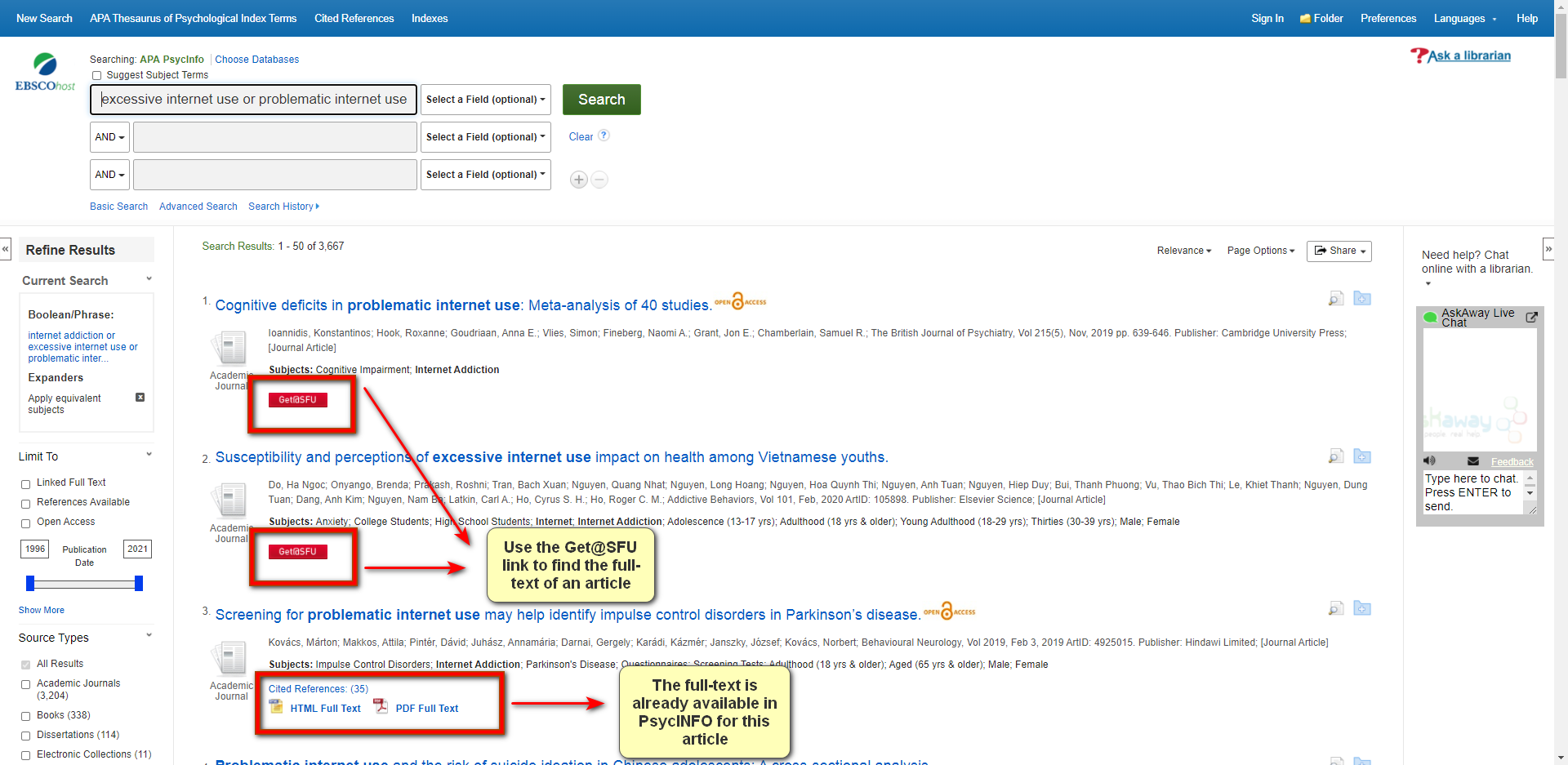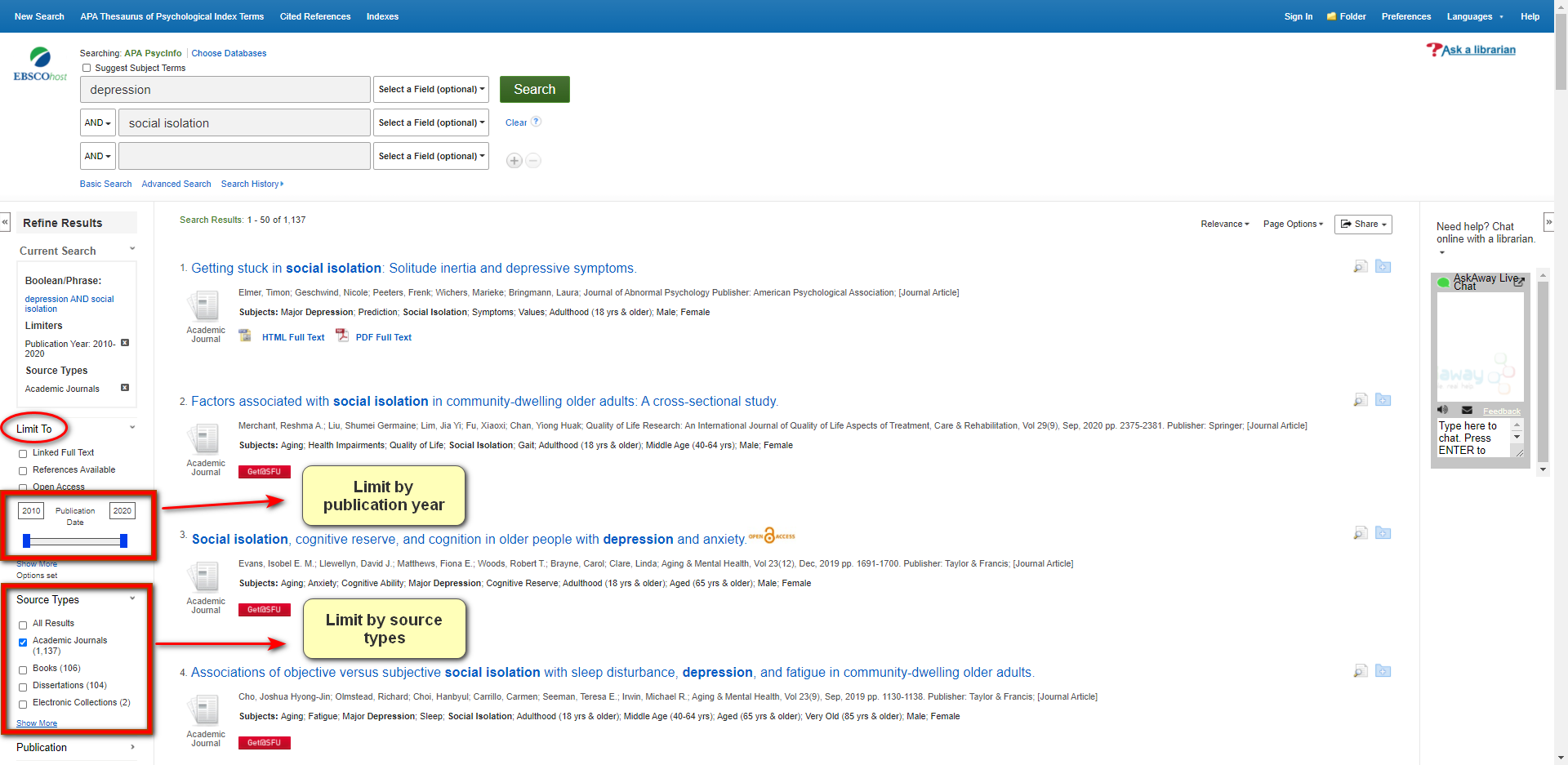On this page
Spring 2022: This guide is for Professor Day's class, Introduction to Psychology II, section D100. Please see the main Psychology guide for other Psychology course guides and resources.
Psyc 102
This guide begins with some broad information on finding scholarly articles in PsycINFO, followed by more specific information on locating two articles with different underlying theoretical perspectives for your assignment.
Finding a scholarly article in PsycINFO
For your assignment, you are required to locate two peer-reviewed, scholarly articles using the Psychology-specific database, PsycINFO. Notably, almost all of PsycINFO's indexed journals are scholarly. This distinguishes PsycINFO from other databases such as Academic Search Premier which contain a mixture of academic journals and popular/practitioner periodicals.
Peer-review: while almost all scholarly journals are peer-reviewed, there are a few that are not. Accordingly, you should check the "peer reviewed" box in PsycINFO as an added measure.
After finding your article you will still need to look at the article and double-check whether or not it is a scholarly article. For example, you may find an article that comes from a "peer-reviewed scholarly journal", but is, in fact, a book review.
To learn more about how to identify a scholarly article, please view What is a Scholarly Journal?
Full text access to your articles
Some databases provide the full content (i.e., the full text) of all of the articles listed in it, while others provide only the citation. PsycINFO provides a combination of full text articles and citations to articles.
Your articles must be cited in PsycINFO to meet your assignment criteria. However, you may obtain the actual full text of the article (e.g. PDF) from any of our databases, as long as you found the original article citation in PsycINFO. Simply click on the Get@SFU link via PsycINFO, if need be, and follow the links to see which other databases might have the full text, if need be.
(Note: SFU Library provides access to over 100,000 online journals, and over 500 databases, so we often have access elsewhere! If we do not have access, you may still likely obtain online access by submitting a free interlibrary loan request.)

If you are still having trouble locating the full text of an article cited in PsycINFO, please Ask A Librarian.
Finding on-topic articles
Before you start searching, it helps to clearly understand your topic.
- Identify the KEY CONCEPT(S) of your assigned topic, for example: drug abuse. You may need to read ahead in your textbook if you are assigned a topic not covered in class yet.
- Make a list of RELATED SEARCH TERMS for each concept that you can include to increase your results. If a simple search for drug abuse, for instance, is not providing a large enough pool of results, you may wish to add more keywords that represent similar or synonymous concepts: alcohol abuse, drug dependency, drug addiction, etc.
Research Concepts Worksheet Use this worksheet to help brainstorm keyword ideas.
A good way to enter search terms into a database like PsycINFO is to devote one search box to each concept.

Using Search Limiters - Date Range & Author Last Name
On either the main search screen of PsycINFO, or the left-hand side bar once you've run your search, you can limit your article by various parameters. For instance:
- Your research articles from PsycINFO should be academic articles (also called scholarly articles). Because PsycINFO indexes other sources such as dissertations, book chapters, and encyclopedias as well, try limiting your search to academic articles only, by selecting "academic journals" under the source type limiter.
- To limit to articles published within a certain time range, make use of the publication year limiter.
- Unfortunately, there is no direct way to limit your search by the first letter of one of the authors' last names. You will have to manually skim the results.

Psyc 102 D100 Assignment: Differentiating Theoretical Foundations of Research
For your Psyc 102 assignment, you are asked to find two articles about the same topic, but based on two different underlying theoretical perspectives.
There is unfortunately no technical way to run a search in PsycINFO that will limit your search results only to those belonging to a particular theoretical perspective. However, there are several techniques you can use to return more on-topic results.
Note: You will need to narrow your assigned general topic from the broad one assigned to effectively search for articles.
1. Add keywords likely to be associated with a theoretical perspective
Adding keywords likely to be associated with a particular theoretical perspective can help you narrow down large sets of results. For instance, a keyword search for depression in PsycINFO currently retrieves over 350,000 results - far too many to look through. Even after limiting to a three-year time period, you may still have over 50,000 results. To narrow down your results, try adding keywords associated with particular theoretical perspectives. Keywords can include the name of the theory itself, e.g., humanistic.
Example keywords related to broad theoretical perspectives: psychodynamics, "object relations" (psychodynamic); dopamine, endocrine (biological neuroscience); humanistic, actualization (humanistic); ethnology, "social processes",(sociocultural); "cognitive bias", attention (cognitive), punishment, reinforcement (behavioral), "natural selection", genetics (evolutionary)
There are thousands of possibilities.
2. Think about what broader theoretical perspective your article may belong to
You may find articles that reporting research on a ‘similar issue’ (same construct) through a narrower theoretical perspective to the broad ones. Some of the main theoretical perspectives in Psychology include: Biological Neuroscience, Psychodynamic, Humanist, Cognitive, Behavioural, Sociocultural and Evolutionary. If using an article from a narrower perspective, think about the broader theoretical view it might belong to: your article-in-hand may actually be applicable. On the other hand, you want to ensure you are not selecting two articles belonging to the same broad perspective.
Examples: Cellular Neuroscience and Developmental Neuroscience are narrower theoretical fields of the larger field of biological neuroscience psychology; Transpersonal Psychology is a subdiscipline of Humanistic Psychology
3. Apply your article date and author limits after you run your topical search
You may find it beneficial to focus on getting your pool of search results on-topic first before you begin to apply the necessary author and date limits (remember, for each of the articles, only ONE of the authors' last names needs to be within the letter range restriction). By waiting to limit your search, you can try different combinations of subject keywords, making your search results as topically relevant as possible before you start adding those limiters.
4. Add additional specific keywords to find articles reporting on the same construct
One of the challenges of this assignment will be to find articles that both report on a ‘similar issue’ (same construct),. You are, of course, limited to the pool of scientific studies that have already been published and indexed in PsycINFO. As the topics of studies published in peer-reviewed academic journals are usually very narrow in scope, finding two articles which report on the exact same hypothesis can be very challenging or impossible to find (because they may not exist). However, articles which report on the same construct are more easily found.
There is no way to search specifically by hypothesis in PsycINFO. However, using specific keywords that denote your construct will usually work. In some cases, you may wish to try using subject headings for your search, if the keywords aren't bringing you good results. (For more detailed information, please see What are subject headings? (tutorial section) and Subject headings vs. keywords which provides an example from Psychology)
For instance, if your topic is dreaming (over 7,000 articles in PsycINFO!), to locate articles with similar articles, you could try narrowing your search by adding a more specific keyword like insomnia to your search (search = dreaming AND insomnia). It's best to add these extra keywords after you have generated a large pool of search results that are generally on the same topic, so you know how much to narrow your topic by.
You may need also to reflect upon how flexible you can be with your assigned topics - particularly if your pool of search results is quite small. For instance, if you are looking at an experiment about the affect of sleep deprivation on children with respect to anxiety, would a similar experiment done on adults be acceptable? What about if the effect being measured is depression or mood instead? You will likely find it quite challenging (or not even possible) to find two studies that explore exactly the same construct across all variables (e.g., demographic, intervention, outcome).
Your judgment about the similarity of the two articles is a key aspect of the assignment, so care in selecting your two articles is important. Please consult your TA or instructor if you need additional guidance.
For more tips on identifying primary and empirical research, please see this Suffolk University Psychology guide.
APA citing and style
The American Psychological Association (APA) Style Manual provides the main writing, formatting, and citation style guidelines used in the field of Psychology. Importantly, the Manual provides guidance on how to cite your sources in-text and in your reference list.
APA recently released the 7th edition of the APA Style Guide in late 2019. This is the first new edition in 10 years.
Helpful online 7th edition APA resources:
- SFU Library's guide to using APA
- Purdue Online Writing Lab - APA Guide* (link from Prof Day's assignment syllabus. See also: Purdue's APA Sample Paper)
- The official APA Style Blog (7th edition - current)
- APA's Introduction to the 7th edition
- APA 7th edition guide to Bias-Free Language
- Massey University’s interactive APA (7th ed.) guide allows users to create examples for reference lists and in-text citations. Includes explanations for how to format parts of the citation, examples on incorporating in-text citations into a body of work, and additional information on referencing.
- Notable to Changes to APA Style (infographic) and a quick guide to APA style , both by College of Dupage Library
Note: The SFU Library also lends out physical copies of the full APA style manual itself. (Unfortunately, no digital copies of the APA style manual are available for institutional purchase at this time).
